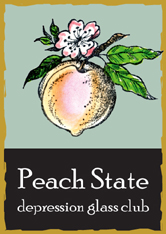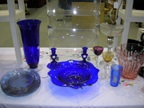Depression Glass Patterns
History of Paperweights
Some of the glass processes used in modern paperweights were around centuries before Christ, but the actual glass paperweights we think of today began being produced in the 19th century. The history of paperweights can be divided into three main periods.
1. Classic Period: approximately 1840-1880
- French companies such as Clichy, St. Louis, Baccarat and Pantin made some of the most beautiful and sought after paperweights. They are quite expensive today. The French used the optical qualities of the glass to their advantage and they were considered art that you could pick up and handle and look at from different views.
- English companies during this period included Walsh-Walsh, Whitefriars & Bacchus.
- American companies included Boston & Sandwich, New England Glass Company and Pairpoint.
2. Folk Art & Advertising Period: 1880s into the late 1940s
- Large glass factories declined and small family-run glass factories made paperweights.
3. Contemporary Period: Late 1940s to the present
- Studio glass artists began working on their own, creating paperweightworks of art again.
Collecting Paperweights
As far as collecting paperweights goes, there are generally four approaches:
1. Type collecting is probably the most common. This is when you collect a good example of each type of paperweight.
2. Theme collector Collects weights that have one theme: like all birds or a certain flower or sulfides of the presidents.
3. In-depth collector specializes in ONE type of paperweight. This kind of collector usually becomes an expert on one specific type of paperweight and can distinguish between manufacturers.
4. Most people fall into this category or at least start out collecting in this manner.
Types of Paperweights
Paperweights come in a variety of shapes, styles and materials. From celluloid to cast iron, crystal to glass, collectors often specialize in just one of area of them. Here are a few techniques regarding glass paperweights which are still being used today.
 |
Millefiori paperweights contain thin cross-sections of cylindrical composite canes made from colored rods and resemble small flowers. These are usually made in a factory setting. They exist in many variations such as scattered patterned, close concentric or carpet ground. |
 |
Lampwork paperweights have objects such as flowers, fruit, butterflies, or animals constructed by shaping and working bits of colored glass with a gas burner or torch and assembling them into attractive compositions which are then incorporated into the dome. This is a form particularly favored by studio artists. |
 |
Sulfide paperweights have an encased three dimensional medallion or portrait plaque made from a ceramic. They often are produced to commemorate some person or event. |
 |
Swirl paperweights have opaque rods of two or three colors radiating like a pinwheel from a central millefiori floret. And just like a pinwheel, one can become lost in the swirl of color if looked at for a long period of time./ |
 |
California paperweights are made by "painting" the surface of the dome with colored paints, molten glass and then manipulated with picks or other tools. They may also be sprayed while hot with various metallic salts to achieve an iridescent look. |
 |
Victorian Portrait and Advertising paperweights were dome glass paperweights first made in Pittsburgh, Pennsylvania using a process patented in 1882 by William H. Maxwell. The portrait paperweights contained photos of ordinary people reproduced on a milk-glass disk and encased within clear glass. With the Industrial Revolution changing the demographic nature of the United States, the role of advertising was transforming as well. What was once ephemeral and trade card advertising was now giving way to the "give away" glass advertising paperweight. |
Paul Jokelson
Paul Jokelson - Short Bio
For many years, Paul Jokelson has been called "The King of Paperweights" because of his pivotal role in the birth of modern paperweight making. When Paul was in Paris as a young man, he began his love affair with paperweights with his purchase of the "Bird in the Nest" for about $25. (Many years later, it sold at auction for $280,000.) Jokelson then spent years searching for other paperweights in order to know more about them. But he found that after many decades in which glass paperweights fell out of vogue among collectors and glass artists, few paperweights were available, and the skills needed to make them were almost forgotten.
In the early 1950s, Jokelson persuaded the Saint Louis and Baccarat glass factories of France to reinvent the art form. They did, and thus began the rally among glass workers worldwide to pursue this most difficult of all the glass arts, evolving into the art form it is today.
Jokelson's influence on the world of glass paperweights was so profound that many doubt the art form would have ever been revived without him.



